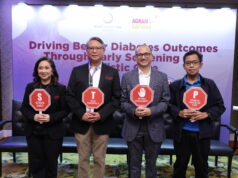DURBAN, SOUTH AFRICA — Some 2.5 million people are still becoming infected with HIV every year even as drugs have slashed the death rate and patients live longer than ever, a global AIDS study said Tuesday.
New infections have plateaued after a steep dip from the peak rate of 3.3 million in 1997, said the authors of a comprehensive analysis in The Lancet HIV journal.
It was published to coincide with the International AIDS conference underway in Durban, South Africa to assess progress in stemming an outbreak that has killed more than 30 million people since the 1980s.
The report paints “a worrying picture of slow progress in reducing new HIV infections,” according to lead author Haidong Wang from the Institute for Health Metrics and Evaluation (IHME) at the University of Washington, Seattle.
Peter Piot, director of the London School of Hygiene and Tropical Medicine and founding executive director of UNAIDS, said the figure was “staggering” and “means that AIDS is not over.”
“New infections of HIV in the world is probably the most disturbing factor that has been announced here at the conference,” he added.
The situation could be worsened by funding shortages for HIV/AIDS programs and medicines.
“In 2015, [funding] fell below the level spent in 2014, and in many low-income countries, resources for health are scarce and expected to grow slowly, if at all,” said Wang at a press conference in Durban.
“We must slow rates of new infection.”
IHME director Christopher Murray said in a statement a massive increase in effort from governments and international agencies was necessary to meet the estimated $36 billion needed every year to realize the goal of ending AIDS by 2030.
Over the past 15 years, countries have contributed $110 billion in “development assistance” for HIV/AIDS programs.

‘DRAMATIC CHANGE’ REQUIRED
Today, there are some 38.8 million people living with the AIDS-causing virus, a steady increase from 28 million in 2000 thanks to the advent in 1996 of life-prolonging antiretroviral therapy (ART).
Annual AIDS deaths have declined from a peak of 1.8 million in 2005 to 1.2 million in 2015.
There is no AIDS cure or vaccine. ART cocktails suppress the virus, enabling people to live long lives, though the drugs are expensive and can have side effects.
Use of antiretrovirals, for long the preserve of the rich, grew from 6.4% of infected men in 2005 to 38.6% 10 years later, and from 3.3% to 42.4% for women over the same period, the study found.
Another factor that has helped cut the death rate was education and medicines to prevent infected women passing the virus onto their unborn children.
The study saw researchers collate HIV data recorded from 1980 to 2015 for 195 countries.
In spite of advances, most countries are still far from achieving the UNAIDS goal of ensuring that by 2020, 90% of infected people will know their status, and 90% of those will receive ART.
In 2015, 41% of HIV-infected people received ART, said the report.
“More than 60% of men and more than 57% of women living with HIV are not on medication,” said Wang.
The picture varied vastly between countries and regions.
In 2015, 1.8 million new HIV infections, some 75%, were in sub-Saharan Africa, followed by 8.5% in south Asia.
“The highest rates of infection were in southern Africa, with more than 1% of the population per year becoming infected in Botswana, Lesotho and Swaziland,” said the report.
In Europe, the highest rate of new infections was in Russia and Ukraine.
“Global efforts have had less impact on the incidence of new infections than on HIV mortality,” concluded the report.
“Ending the AIDS epidemic by 2030 will require a dramatic change in how HIV prevention is pursued.” — AFP



